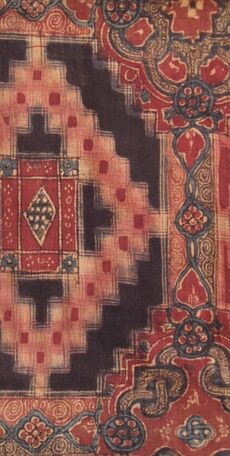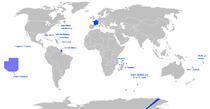ساحل كوروماندل
13°22′00″N 80°20′00″E / 13.3667°N 80.3333°E
The Coromandel Coast is the southeastern coastal region of the Indian subcontinent, bounded by the Utkal Plains to the north, the Bay of Bengal to the east, the Kaveri delta to the south, and the Eastern Ghats to the west, extending over an area of about 22,800 square kilometres.[1] The coast has an average elevation of 80 metres and is backed by the Eastern Ghats, a chain of low lying and flat-topped hills.
The land of the Chola dynasty was called Cholamandalam in Tamil, literally translated as "the realm of the Cholas", from which Coromandel is derived.
In historical Muslim sources from the 12th century onward, the Coromandel Coast was called Maʿbar.[2]
. . . . . . . . . . . . . . . . . . . . . . . . . . . . . . . . . . . . . . . . . . . . . . . . . . . . . . . . . . . . . . . . . . . . . . . . . . . . . . . . . . . . . . . . . . . . . . . . . . . . . . . . . . . . . . . . . . . . . . . . . . . . . . . . . . . . . . . . . . . . . . . . . . . . . . . . . . . . . . . . . . . . . . . .
Etymology
The land of the Chola dynasty was called Cholamandalam (சோழ மண்டலம்) in Tamil, translated as The realm of the Cholas, from which the Portuguese derived the name Coromandel.[3][4][5][6][7] The name could also be derived from Karai mandalam, meaning The realm of the Shores.[8]
Coromondel is the Dutch pronunciation of the word "Karimandalam", a village in the Sriharikota island in the north of Pazhavercadu (Pulecat Lake).[9] An Italian explorer, Ludovico di Varthema, perhaps first gave the name Coromandel in 1510, which was then used on maps by the Portuguese, but it was the Dutch who took up serious trading there.[10]
Flora
The Coromandel Coast is home to the East Deccan dry evergreen forests ecoregion, which runs in a narrow strip along the coast. Unlike most of the other tropical dry forest Biome regions of India, where the trees lose their leaves during the dry season, the East Deccan dry evergreen forests retain their leathery leaves year round.[بحاجة لمصدر]
The Coromandel Coast is also home to extensive mangrove forests along the low-lying coast and river deltas, and several important wetlands, notably Kaliveli Lake and Pulicat Lake, that provide habitat to thousands of migrating and resident birds.[بحاجة لمصدر]
History

By late 1530 the Coromandel Coast was home to three Portuguese settlements at Nagapattinam, São Tomé de Meliapore, and Pulicat . In the 17th and 18th centuries, the Coromandel Coast was the scene of rivalries among European powers for control of the India trade. The British established themselves at Fort St George (Madras) and Masulipatnam, the Dutch at Pulicat, Sadras and Covelong, the French at Pondicherry, Karaikal and Nizampatnam, the Danish in Dansborg at Tharangambadi.[بحاجة لمصدر]
The Coromandel Coast supplied Indian Muslim eunuchs to the Thai palace and court of Siam (modern Thailand).[11][12] The Thai at times asked eunuchs from China to visit the court in Thailand and advise them on court ritual since they held them in high regard.[13][14]
Eventually the British won out, although France retained the tiny enclaves of Pondichéry and Karaikal until 1954. Chinese lacquer goods, including boxes, screens, and chests, became known as "Coromandel" goods in the 18th century, because many Chinese exports were consolidated at the Coromandel ports.[بحاجة لمصدر]
Two of the famous books on the economic history of the Coromandel Coast are Merchants, companies, and commerce on the Coromandel Coast, 1650–1740 (Arasaratnam, Oxford University Press, 1986) and The World of the Weaver in Northern Coromandel, ح. 1750 (P. Swarnalatha, Orient Longman, 2005).
On 26 December 2004, one of the deadliest natural disasters in modern history, the Indian Ocean earthquake, struck off the western coast of Sumatra (Indonesia). The earthquake and subsequent tsunami reportedly killed over 220,000 people around the rim of the Indian Ocean. The tsunami devastated the Coromandel Coast, killing many and sweeping away many coastal communities.[بحاجة لمصدر]
Applications of the name
Four ships of the Royal Navy have borne the name إتشإمإس Coromandel after the Indian coast. The Coromandel Peninsula in New Zealand was named after one of these ships, and the town of Coromandel, New Zealand was named after the peninsula. Coromandel Valley, South Australia, and its neighbouring suburb, Coromandel East, gained their names from the ship Coromandel, which arrived in Holdfast Bay from London in 1837 with 156 English settlers. After the ship reached the shore, some of its sailors deserted, intending to remain behind in South Australia, and took refuge in the hills in the Coromandel Valley region.[بحاجة لمصدر]
In Slovene, the idiom Indija Koromandija (India Coromandel) means a land of plenty,[15] a promised land, a utopia where "Houses are bleached with cheese and covered with cake".[16]
Edward Lear situates his nonsense poem The Yonghy Bonghy Bo by citing Coromandel on the first line: On the Coast of Coromandel.[17]
See also
References
- ^ Encyclopædia Britannica entry on Coromandel Coast
- ^ Shokoohy, Mehrdad; Shokoohy, Natalie H. (2020). "Maʿbar". Encyclopedia of Islam (third ed.). Brill. ISBN 9789004435933. Retrieved 9 March 2021.
- ^ The Land of the Tamulians and Its Missions, by Eduard Raimund Baierlein, James Dunning Baker
- ^ South Indian Coins – Page 61 by T. Desikachari – Coins, Indic – 1984
- ^ Indian History – Page 112
- ^ Annals of Oriental Research – Page 1 by University of Madras – 1960
- ^ The Periplus of the Erythræan Sea by Wilfred Harvey Schoff
- ^ Edgar Thurston (2011). The Madras Presidency with Mysore, Coorg and the Associated States. Cambridge University Press. p. 11. ISBN 978-1-107-60068-3.
- ^ Topographic Map of India "66C/7 & 66C/11" by Survey of India
- ^ Allen, Charles (13 December 2017). "How A Coast Got Its Name". Books. The Hindu. Retrieved 24 December 2020.
- ^ Peletz (2009), p. 73 Gender Pluralism: Southeast Asia Since Early Modern Times, p. 73, في كتب گوگل
- ^ Peletz (2009), p. 73 Gender Pluralism: Southeast Asia Since Early Modern Times, p. 73, في كتب گوگل
- ^ Peletz (2009), p. 75 Gender Pluralism: Southeast Asia Since Early Modern Times, p. 75, في كتب گوگل
- ^ Peletz (2009), p. 75 Gender Pluralism: Southeast Asia Since Early Modern Times, p. 75, في كتب گوگل
- ^ "Indija Koromandija". Slovar slovenskega knjižnega jezika [Dictionary of Slovenian Literary Language] (in السلوفانية). Retrieved December 24, 2020.
According to popular belief, a land where everything is enough, where it is very good: their grandmother told them about India Coromandel / expressing all of her India Coromandel collapsed imaginary, expected happiness
- ^ "Razvezani jezik - Indija koromandija". Free dictionary of living Slovene (in السلوفانية). Retrieved December 24, 2020.
A folk song sings: India Koromandija! /They cook the porridge in a spoon, /the house are bleached with cheese,/ cover them with cake,/ and curd them with cottage cheese. It also houses the first Slovene anti-utopia, created by Anton Mahnič in In 1884 he published in Slovene, a political newspaper for the Slovene nation.
- ^ "Edward Lear Home Page".
Further reading
"India". World Statesman. Retrieved December 24, 2020. Search for Dutch India and French India for information on Coromandel coast
External links
خطأ لوا في وحدة:Authority_control على السطر 278: attempt to call field '_showMessage' (a nil value).
- Pages using gadget WikiMiniAtlas
- CS1 السلوفانية-language sources (sl)
- Short description is different from Wikidata
- Coordinates on Wikidata
- Articles with unsourced statements from March 2020
- Articles with unsourced statements from January 2022
- Articles with unsourced statements from August 2022
- Coromandel Coast
- Coasts of India
- South India
- Regions of India
- Regions of Andhra Pradesh
- Regions of Tamil Nadu
- Landforms of Puducherry
- Landforms of Tamil Nadu
- Eastern Ghats
- Natural regions of Asia
- Colonial India
- Danish India
- Dutch India
- French India
- Former Dutch colonies
- مستعمرات فرنسية سابقة


